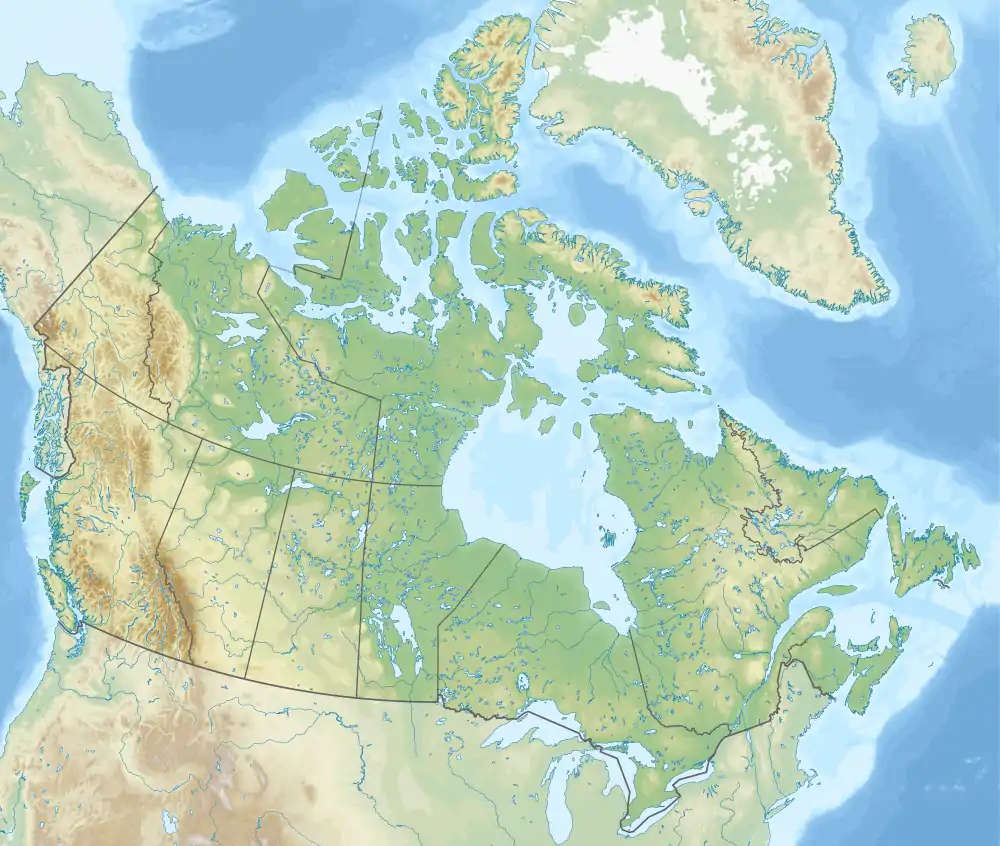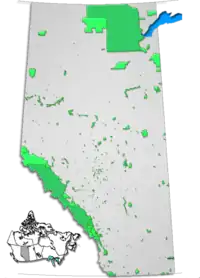Elk Island National Park
Elk Island National Park (French: parc national Elk Island) is a national park in Canada that played an important part in the conservation of the Plains bison. The park is administered by the Parks Canada Agency. This "island of conservation" is located 35 km east of Edmonton, Alberta along the Yellowhead Highway, which goes through the park. It is Canada's eighth smallest in area but largest fully enclosed national park, with an area of 194 square kilometres (75 sq mi).
| Elk Island National Park | |
|---|---|
IUCN category II (national park) | |
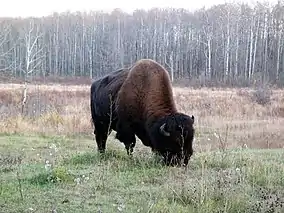 Bison grazing in Elk Island National Park | |
| Location | Alberta, Canada |
| Nearest city | Edmonton |
| Coordinates | 53°36′52″N 112°51′58″W |
| Area | 194 km2 (75 sq mi) |
| Established | 1913 |
| Visitors | 220,758 (in 2012/13[1]) |
| Governing body | Parks Canada |
Improvement District No. 13 | |
|---|---|
Improvement district | |
.svg.png.webp) Location within Alberta | |
| Coordinates: 53°36′52″N 112°51′58″W | |
| Country | |
| Province | |
| Region | Central Alberta |
| Census division | No. 11 |
| Established | April 1, 1958 |
| Renumbered | January 1, 1969[2] |
| Government | |
| • Governing body | Alberta Municipal Affairs (AMA) |
| • Minister of AMA | Deron Bilous |
| Area (2016)[4] | |
| • Land | 165.05 km2 (63.73 sq mi) |
| Population (2016)[4] | |
| • Total | 0 |
| • Density | 0/km2 (0/sq mi) |
| Time zone | UTC-7 (MST) |
| • Summer (DST) | UTC-6 (MDT) |
| Postal code | T8L 2N7 |
| Website | Parks Canada |

The park is representative of the northern prairies plateau ecosystem and as such, the knob and kettle landscape is a mix of native fescue grassland that has been converted to forage land dominated by non-native grasses, aspen parkland and boreal forest. As well, Elk Island plays host to both the largest and the smallest terrestrial mammals in North America, the wood bison and pygmy shrew respectively.
History
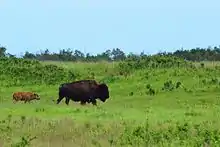
Elk Island National Park is situated in the Beaverhills area, which with its aspen thickets and easy access to water, has provided shelter for wintering herds of elk, bison and moose since times immemorial.[5] Though there was never any permanent First Nations settlement in the area, there are over 200 archaeological remains of campsites and stone tool-making sites. The land has been influenced by the Blackfoot, Sarcee and Cree Aboriginal Canadians.[6]
In early post-Contact history, the Beaverhills area was primarily used for commercial hunting. This led to over-hunting and the virtual elimination of beaver from the area by the 1830s and of large ungulates by the 1860s. The area then became valuable for timber until 1894, when fire swept through the area. In 1899, the federal government designated the area the "Cooking Lake Forest Reserve". But while the forest was protected, it did little to protect the moose, elk and deer populations. Thus, in 1906,[7] five men from Fort Saskatchewan put forward $5000 and petitioned the federal government to set up an elk sanctuary, calling it "Elk Park". Elk Island Park was later granted federal park status in 1913, and then designation as an official National Park under the National Parks Act which passed through the Canadian Parliament in 1930.
In 1951, a replica of a pioneer cabin was built in the park to honour the Ukrainian Canadians who pioneered the area. This replica, known as the Ukrainian Pioneer Home, was the first museum or historic site ever dedicated to Ukrainian immigration in Canada. In 1993 it was declared a Classified Federal Heritage Building by the federal government.[8]
Wildlife
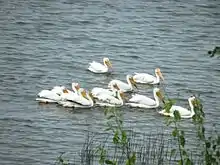
Elk Island is home to the densest population of ungulates (hoofed mammals) in Canada. A variety of mammal species including coyote, bison, moose, mule deer, lynx, beaver, elk, white-tailed deer, and porcupine are year-round residents. Black bears and timber wolves certainly roam within this park, but they are not commonly seen by wildlife viewers.[9][10] Over two hundred and fifty bird species that can be found in the park at various times of year. Most notable among these are the red-necked grebes, American white pelicans, double-crested cormorants, great blue herons, red-tailed hawks, American bitterns and the trumpeter swans.
 Astotin Lake
Astotin Lake
Wildlife management
Elk Island National Park maintains a thriving elk population, estimated at 605 in 2007, as well as around 300 moose and over 500 deer. Parks Canada transferred eighteen moose from Elk Island to Nova Scotia's Cape Breton Highlands National Park between 1947 and 1948. Reintroduction of traditional species has been an important focus as well. Besides the success of the wood and plains bison introduction, beavers were reintroduced in 1942, and in 2007 numbered near 1000. 1987 saw the beginning of a Trumpeter Swan reintroduction program me which is now seeing mating pairs returning to Elk Island, raising hope for a sustainable population.
Elk Island National Park also remains a seed herd for repopulation efforts in other areas. Elk Island elk have been relocated to various parts North America, including Ontario and the foothills of the Rocky Mountains. Plains bison have been reintroduced to conservation areas scattered throughout their historic domain, for example American Prairie Reserve in eastern Montana, Grasslands National Park and the Old Man on His Back Prairie and Heritage Conservation Area in Saskatchewan, and in 2006, 30 wood bison were relocated to the Republic of Sakha (Yakutia) to begin repopulation efforts of the area historically inhabited by the now extinct steppe bison.[11]
Bison conservation
Elk Island National Park has a prominent history in large ungulate conservation. As early as 1907,[12] the Canadian government bought one of the last and largest remaining pure-bred plains bison, the Pablo-Allard herd, from Montana. Close to 400 bison were shipped to Elk Island as a temporary waystation until the fencing at Buffalo Park in Wainwright was completed. In 1909 the fence was finished and 325 bison were relocated to Buffalo National Park. However, 40-70 bison[12] evaded capture and became the ancestors of today's herd in Elk Island National Park. In 2007, Parks Canada maintained a herd of about 450 plains bison in Elk Island. When the Bison number over this amount they are sold. The proceeds of the sales go to help finance the needs of national parks.[12]
In the late 19th century, only 300 wood bison remained worldwide, almost exclusively in Wood Buffalo National Park. During the 1920s, 6000-7000 plains bison were also relocated to Wood Buffalo National Park. These bison were not only infected with brucellosis and tuberculosis, which infected the wood bison herd, but the wood and plains subspecies also interbred, and thus it was thought that wood bison were completely extinct by the 1940s. In 1957, however, a disease-free, not fully but relatively pure wood bison herd of 200 was discovered near Nyarling river in Wood Buffalo National Park. In 1965, 23 of these bison were relocated to the south side of Elk Island National Park and remain there today as the most genetically pure wood bison remaining. In 2007, the wood bison population in Elk Island National Park was estimated at 315.
Elk Island has become famous for exporting its ungulates to other conservation areas around North America, and even to Russia. In 1996 elk were sent to Land Between The Lakes National Recreation Area in Kentucky.[13] Starting in 2005, a series of plains bison deliveries were made to the American Prairie Reserve in northeastern Montana, including 94 head in 2010 and 72 in 2012.[14] Three groups of 30 wood bison were sent to the Republic of Sakha, in the Russian Federation, partly to replace the extinct steppe bison in the habitat but also a protection against any disease wiping out the North American herd of that species.[15][16]
Conservationists transferred fifty-three wood bison from this national park to the Alaska Wildlife Conservation Center in June 2008. They were absent from Alaskan boreal forests for nearly one hundred years.[17]
Climate
| Climate data for Elk Island National Park | |||||||||||||
|---|---|---|---|---|---|---|---|---|---|---|---|---|---|
| Month | Jan | Feb | Mar | Apr | May | Jun | Jul | Aug | Sep | Oct | Nov | Dec | Year |
| Record high humidex | 11.5 | 14.1 | 19.5 | 24.6 | 32.3 | 34.9 | 39.2 | 42.2 | 34.3 | 26.2 | 19.0 | 14.1 | 42.2 |
| Record high °C (°F) | 11.7 (53.1) |
15.5 (59.9) |
20.7 (69.3) |
26.5 (79.7) |
31.0 (87.8) |
33.3 (91.9) |
35.4 (95.7) |
34.5 (94.1) |
30.9 (87.6) |
28.5 (83.3) |
20.0 (68.0) |
14.8 (58.6) |
35.4 (95.7) |
| Average high °C (°F) | −6.2 (20.8) |
−2.5 (27.5) |
1.2 (34.2) |
10.8 (51.4) |
17.0 (62.6) |
20.8 (69.4) |
23.2 (73.8) |
22.1 (71.8) |
16.1 (61.0) |
9.9 (49.8) |
−0.3 (31.5) |
−4.1 (24.6) |
9.0 (48.2) |
| Daily mean °C (°F) | −12.0 (10.4) |
−9.3 (15.3) |
−5.1 (22.8) |
4.2 (39.6) |
10.6 (51.1) |
14.6 (58.3) |
17.0 (62.6) |
15.7 (60.3) |
10.1 (50.2) |
4.3 (39.7) |
−5.2 (22.6) |
−9.5 (14.9) |
3.0 (37.4) |
| Average low °C (°F) | −17.8 (0.0) |
−15.9 (3.4) |
−11.4 (11.5) |
−2.4 (27.7) |
4.1 (39.4) |
8.4 (47.1) |
10.8 (51.4) |
9.2 (48.6) |
4.0 (39.2) |
−1.3 (29.7) |
−10.0 (14.0) |
−15.1 (4.8) |
−3.1 (26.4) |
| Record low °C (°F) | −43.4 (−46.1) |
−40.5 (−40.9) |
−42.5 (−44.5) |
−30.0 (−22.0) |
−7.4 (18.7) |
−0.9 (30.4) |
3.3 (37.9) |
−1.0 (30.2) |
−6.7 (19.9) |
−21.5 (−6.7) |
−35.0 (−31.0) |
−38.5 (−37.3) |
−43.4 (−46.1) |
| Record low wind chill | −45.4 | −40.5 | −35.4 | −26.4 | −13.1 | −1.5 | 0.0 | 0.0 | −8.5 | −21.0 | −37.2 | −42.4 | −45.4 |
| Average precipitation mm (inches) | 18.2 (0.72) |
11.3 (0.44) |
21.5 (0.85) |
26.3 (1.04) |
49.4 (1.94) |
85.3 (3.36) |
112.1 (4.41) |
52.5 (2.07) |
53.7 (2.11) |
20.1 (0.79) |
15.3 (0.60) |
16.8 (0.66) |
482.4 (18.99) |
| Average rainfall mm (inches) | 0.9 (0.04) |
0.2 (0.01) |
2.0 (0.08) |
13.8 (0.54) |
44.0 (1.73) |
85.3 (3.36) |
112.1 (4.41) |
52.5 (2.07) |
53.6 (2.11) |
11.2 (0.44) |
1.2 (0.05) |
0.9 (0.04) |
377.7 (14.87) |
| Average snowfall cm (inches) | 18.5 (7.3) |
11.9 (4.7) |
20.6 (8.1) |
12.8 (5.0) |
5.4 (2.1) |
0.0 (0.0) |
0.0 (0.0) |
0.0 (0.0) |
0.1 (0.0) |
9.2 (3.6) |
15.9 (6.3) |
16.4 (6.5) |
110.7 (43.6) |
| Source: Environment Canada[18] | |||||||||||||
Activities and facts
Elk Island National Park is open 24 hours a day, seven days a week, year round. Park User Fees apply. Winter activities include unserviced camping, hiking, snowshoeing, cross country skiing and wildlife gazing. Summer activities include hiking, golfing, kayaking/canoeing, mountain biking, wildlife gazing and unserviced camping. Services include telephones, potable water and year-round washrooms. Swimming is not recommended due to risk of contracting Swimmer's itch. Fires are allowed in designated fire pits.
On September 3, 2006, the Beaver Hills dark-sky preserve, which includes Elk Island National Park within its boundaries, was declared in a ceremony held at Astotin Lake.[19]
See also
- National Parks of Canada
- List of National Parks of Canada
- Ukrainian Cultural Heritage Village which borders the park
- Kalyna Country, an ecomuseum of which Elk Island is a part
- Beaver Hills (Alberta), the area in which Elk Island lies
- List of parks in Alberta
- List of trails in Alberta
- List of mountains in Alberta
- List of waterfalls of Alberta
References
- "Parks Canada Attendance 2007-08 to 2012-13" (PDF). Parks Canada. July 31, 2013. p. 2. Retrieved May 29, 2014.
- "Location and History Profile". Alberta Municipal Affairs. Retrieved April 25, 2015.
- "Alberta Municipal Affairs". Alberta Municipal Affairs. Retrieved May 25, 2015.
- "Population and dwelling counts, for Canada, provinces and territories, and census subdivisions (municipalities), 2016 and 2011 censuses – 100% data (Alberta)". Statistics Canada. February 8, 2017. Retrieved February 8, 2017.
- MacDonald, Graham A. (2009). The Beaver Hills Country: A History of Land and Life. Edmonton, AB: AU Press, Athabasca University. p. 253. ISBN 978-1-897425-38-1.
- "Elk Island National Park of Canada, 5.0 Protection of Cultural Resources". National Parks of Canada. Parks Canada. 2009. Retrieved May 21, 2014.
- "Elk Island National Park". National Parks of Canada. Parks Canada. 2014. Retrieved May 23, 2014.
- "Ukrainian Pioneer Home". HistoricPlaces.ca. Parks Canada. Archived from the original on April 5, 2012. Retrieved July 25, 2012.
- "Elk Island National Park Cameras Capture Elusive Black Bears (PHOTOS)". Huffington Post. July 23, 2014. Retrieved July 21, 2016.
- "Alberta approves killing six wolves in national park after 'cows ripped open from one end to the other'". Postmedia News. National Post. October 27, 2014. Retrieved July 21, 2016.
- "Oh give me a home: Elk Island National Park transfers wood bison to Russia". The Globe and Mail. Toronto, Ontario, Canada. The Canadian Press. March 28, 2013. Retrieved May 23, 2015.
- "History of the Herds – Plains Bison". Elk Island National Park. Parks Canada. 2012. Retrieved May 23, 2014.
- "Hear Fall Bugling at Land Between The Lakes Elk & Bison Prairie". Grand Rivers. September 13, 2013. Archived from the original on May 24, 2015. Retrieved May 23, 2015.
- Proulx, Ben (February 2, 2012). "Elk Island bison head to Montana". Fort Saskatchewan Record. Retrieved May 23, 2015.
- Heck, Dalene. "From Extinction to Alberta: the Bison's Tale". Hecktic Travels. Retrieved May 23, 2015.
- Brooymans, Hanneke (August 5, 2010). "Elk Island wood bison big hit in Russia". Edmonton Journal. Archived from the original on November 29, 2014. Retrieved May 23, 2015.
- https://www.alaskawildlife.org/wood-bison-restoration/
- "Elk Island National Park". Canadian Climate Normals 1981–2010 (in English and French). Environment Canada. Retrieved February 27, 2014.
- "Beaver Hills Dark-Sky Preserve". Royal Astronomical Society of Canada. Archived from the original on June 16, 2012. Retrieved July 25, 2012.
External links
| Wikimedia Commons has media related to Elk Island National Park. |
| Wikivoyage has a travel guide for Elk Island National Park. |
